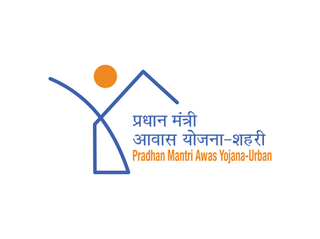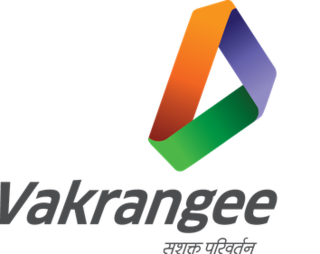
Vijaya Bank was a PSU bank which was merged with Bank of Baroda on 1 April 2019 with its head office in Bangalore, Karnataka, India. It was one of the nationalised banks in India. The bank offered a wide range of financial products and services to customers through its various delivery channels. As of March 2017, the bank had a network of 2031 branches throughout the country and over 4,000 customer touch points including 2001 ATMs.

The Pradhan Mantri Gram Sadak Yojana (PMGSY) is a nationwide plan in India to provide good all-weather road connectivity to unconnected villages. Of 178,000 habitations with a population of above 500 in the plains and above 250 in the hilly areas planned to be connected by all-weather roads, 82% were already connected by December 2017 and work-in-progress on the remaining 47,000 habitations was on-track for completion by March 2019.
Social security in India includes a variety of statutory insurances and social grant schemes bundled into a formerly complex and fragmented system run by the Indian government at the federal and the state level. The Directive Principles of State Policy, enshrined in Part IV of the Indian Constitution reflects that India is a welfare state. Food security to all Indians are guaranteed under the National Food Security Act, 2013 where the government provides highly subsidised food grains or a food security allowance to economically vulnerable people. The system has since been universalised with the passing of The Code on Social Security, 2020. These cover most of the Indian population with social protection in various situations in their lives.
The National Pension System (NPS) is a defined-contribution pension system in India regulated by the Pension Fund Regulatory and Development Authority (PFRDA) which is under the jurisdiction of the Ministry of Finance of the Government of India. National Pension System Trust was established by PFRDA as per the provisions of the Indian Trusts Act of 1882 to take care of the assets and funds under this scheme for the best interest of the subscriber.

Agriculture in India is highly susceptible to risks like droughts and floods. It is necessary to protect the farmers from natural calamities and ensure their credit eligibility for the next season. For this purpose, the Government of India introduced many agricultural social insurances throughout the country, the most important one of them being Pradhan Mantri Fasal Bima Yojana.
India operates a complex pension system. There are however three major pillars to the Indian pension system: the solidarity social assistance called the National Social Assistance Programme (NSAP) for the elderly poor, the civil servants pension and the mandatory defined contribution pension programs run by the Employees' Provident Fund Organisation of India for private sector employees and employees of state owned companies, and several voluntary plans.

Pradhan Mantri Matru Vandana Yojana (PMMVY), previously known as the Indira Gandhi Matritva Sahyog Yojana, is a maternity benefit program run by the government of India. It was originally launched in 2010 and renamed in 2017. The scheme is implemented by the Ministry of Women and Child Development. It is a conditional cash transfer scheme for pregnant and lactating women of 19 years of age or above for the first live birth.

Pradhan Mantri Jan Dhan Yojana is a financial inclusion program of the Government of India open to Indian citizens, that aims to expand affordable access to financial services such as bank accounts, remittances, credit, insurance and pensions. This financial inclusion campaign was launched by the Prime Minister of India Narendra Modi on 28 August 2014. He had announced this scheme on his first Independence Day speech on 15 August 2014.

The 2015 Union budget of India refers to 2015–2016 Union budget of India. The beginning of the budget printing began on 19 February 2015 with the traditional halwa ceremony. From 20 February until the presentation of budget about 100 government employees remained locked up in the North Block of the Secretariat Building, New Delhi, which houses the budget printing press, to maintain secrecy. The budget was presented on 28 February by Finance Minister Arun Jaitley.
Pradhan Mantri Suraksha Bima Yojana is a government-backed accident insurance scheme in India. It was originally mentioned in the 2015 Budget speech by Finance Minister Late Arun Jaitley in February 2015. It was formally launched by the Prime Minister Narendra Modi on 8 May in Kolkata.
Pradhan Mantri Jeevan Jyoti Bima Yojana is a Government-backed Life insurance scheme in India. It was originally mentioned in the year 2015 Budget speech by the then-Finance Minister, late Arun Jaitley in February 2015. It was formally launched by Prime Minister Narendra Modi on 9 May in Kolkata. As of May 2015, only 20% of India's population has any kind of insurance, this scheme aims to increase the number.

Pradhan Mantri Awas Yojana (PMAY) is a credit-linked subsidy scheme by the Government of India to facilitate access to affordable housing for the low and moderate-income residents of the country. It envisaged a target of building 2 crore (20 million) affordable houses by 31 March 2022. It has two components: Pradhan Mantri Awas Yojana(Urban) (PMAY-U) for the urban poor and Pradhan Mantri Awaas Yojana (Gramin) (PMAY-G and also PMAY-R) for the rural poor, the former administered by Ministry of Housing and Urban Affairs and the latter by Ministry of Rural Development. This scheme converges with other schemes to ensure that houses have a toilet, Saubhagya Scheme for universal electricity connection, Ujjwala Yojana LPG connection, access to drinking water and Jan Dhan banking facilities, etc.

The Pradhan Mantri fasal bima yojana (PMFBY) launched on 18 February 2016 by Prime Minister Narendra Modi is an insurance service for farmers for their yields. It was formulated in line with One Nation–One Scheme theme by replacing earlier two schemes National Agricultural Insurance Scheme (NAIS) and Modified National Agricultural Insurance Scheme (MNAIS) by incorporating their best features and removing their inherent drawbacks (shortcomings). It aims to reduce the premium burden on farmers and ensure early settlement of crop assurance claim for the full insured sum.
JAM trinity refers to the government of India initiative to link Jan Dhan accounts, mobile numbers and Aadhaar cards of Indians to plug the leakages of government subsidies.

Vakrangee Limited is a technology company based in Mumbai, India that provides banking, insurance, e-governance, e-commerce, and logistics services. The company is one of the main providers of the software and equipment for voter id cards and Aadhaar cards.
Pradhan Mantri Shram Yogi Maandhan is a social welfare scheme launched by the Ministry of Labour and Employment of the Government of India in February 2019 for poor labourers in the unorganised sector from minimum 18 years of age to maximum 40 years. According to government figures, about 42 crore people in India are associated with the unorganized sector. These people have a chance to take advantage of this scheme.
Atal Bhujal Yojana is a groundwater management scheme launched by Prime Minister Narendra Modi on the 95th birth anniversary of former Prime Minister Atal Bihari Vajpayee, on 25 December 2019. The purpose of the scheme is to improve groundwater management in seven states of India.
The Department of Agriculture and Farmers' Welfare (DA&FW) is one of the three constituent department of Ministry of Agriculture and Farmers' Welfare, the other two being Department of Agriculture Research and Education (DARE) and Department of Animal Husbandry and Dairying. The Department is headed by Minister of Agriculture and Farmers' Welfare.
Gamit Ramilaben Raysingbhai is a tribal social worker from Taparwada Village, Tapi district, Gujarat, India, known for her work in transforming several villages in Gujarat to open-defecation free villages. She is also known for her work for the empowerment of rural women by setting up a large number of self help groups of women. In the year 2022, the government of India honoured Gamit Ramilaben Raysingbhai by conferring the Padma Shri Award for her contribution to social work.









